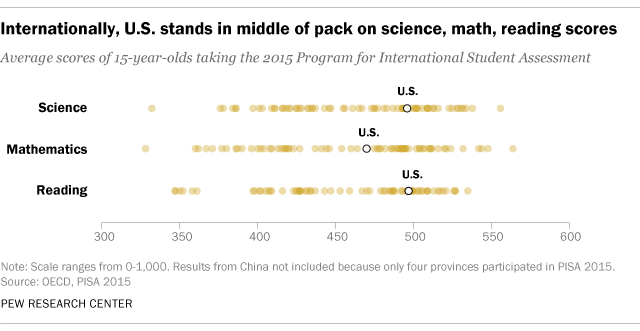From Wiki, The Programme for International Student Assessment (PISA) is a worldwide study by the Organisation for Economic Co-operation and Development (OECD) in member and non-member nations intended to evaluate educational systems by measuring 15-year-old school pupils’ scholastic performance on mathematics, science, and reading. It was first performed in 2000 and then repeated every three years. Its aim is to provide comparable data with a view to enabling countries to improve their education policies and outcomes. It measures problem solving and cognition.
As readers of HBD blogs may know, the U.S. tends to have somewhat mediocre PISA scores, outranking South America, Eastern Europe, and the Middle East, but falling behind East Asian and Northern European countries:

Pundits on both the ‘left’ and ‘right’ see this as evidence of ‘America falling behind’ or ‘dumbing-down’. Furthermore, the HBD-investing thesis and Richard Lynn’s IQ and the Wealth of Nations predicts that high-IQ countries tend to outperform less intelligent ones, yet the apparent decoupling of America’s strong economic and technological gains from its weak PISA performance, runs counter to the theory.
However, PISA scores and rankings provide an incomplete inventory of America’s intellectual strength. Also, the methodology of how PISA results are ranked favors less populated countries. For example, consider a hypothetical country in which only a single person takes the test and get a perfect score. That country would then have the highest PISA ranking. If you look at the countries which rank high and have a lot of ‘level 5’ scores, with the exception of Japan and France, they tend to be very small:

Shanghai has a population of 24 million; Singapore: just 5.6 million; Finland: 5.5 million; Hong Kong: 7.4 million; Canada: 37 million, and so on.
By contrast, the U.S. has a whopping 325 million people, and yet it still has a respectable PISA ranking in spite of large populations of low-performing groups:

Roughly 40% of under-18 Americans are Black or Hispanic. If they are excluded from the results, America’s PISA rankings jump considerably, as does the average scores on the individual sub-tests, yet that is still a lot people left over. America, by virtue of having such a large population, has much more total ‘intellectual capital’ than a smaller country such as Singapore with a higher density of intellect but fewer total smart people. That works to America’s advantage in spite of its mediocre PISA rankings.
Also, due to favorable cultural and economic factors, America is a magnet that attracts smart people from all over the world. This boosts America’s ‘smart faction’ even if average intelligence does not budge much. A country with more total smart people who have the resources and economic incentives to maximize their intellectual potential, will be more successful than a country that has fewer smart people and fewer resources.
Also, breaking down America’s PISA score by individual states, such as Massachusetts and Connecticut as shown above, then the picture improves even more so. If Massachusetts and Connecticut, which have a combined population of 10.5 million people, were treated as a single country, it would rank #5 in ‘level 5’ scores. Florida and Puerto Rico, which have less favorable demographics, rank lower and weigh down the national average.
Imagine a demographic surgeon carved out all the high-performing ‘smart factions’ (such as the Bay Area, Cambridge, Manhattan, Hartford, etc.) and mashed them together to form a new country. Such a hypothetical country would not only likely have a top PISA ranking, but would likely rank number one for GDP/capita, standard of living, access to medical care, technological innovation, educational attainment, and so on.
So when one invests in America, such as the S&P 500, Dow , or Nasdaq, they are investing not in all 325 million people, but rather this proto country which contains all the high-IQ people, defense, biotech, and tech companies. This explains how it’s possible for the U.S. to have such strong economic and stock market performance in spite of mediocre PISA rankings. The bottom-half performing countries such as Brazil, Turkey, and Greece, if we use PISA performance as a proxy for national IQ, have had much lower market returns since 2008 (and especially since 2011) than top-half performing countries, in agreement with the HBD thesis.